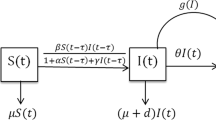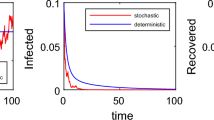Abstract
This paper describes a traditional SIR type epidemic model with saturated infection rate and treatment function. The dynamics of the model is studied from the point of view of stability and bifurcation. Basic reproduction number is obtained and it is shown that the model system may possess a backward bifurcation. The global asymptotic stability of the endemic equilibrium is studied with the help of a geometric approach. Optimal control problem is formulated and solved. Some numerical simulation works are carried out to validate our analytical results.





Similar content being viewed by others
References
Arino J, Cooke KL, van den Driessche P, Velasco-Hernandez J (2004) An epidemiology model that includes a leaky vaccine with a general waning function. Dyn Syst Ser B 4(2):479–495
Bernoulli D (1760) Essai d’une nouvelle analyse de la mortalite cause par la petite verole. Mem math Phy Acad Roy Sci paris 1–45
Birkhoff G, Rota GC (1982) Ordinary differential equations. Ginn, Boston
Buonomo B, Lacitignola D (2011) On the backward bifurcation of a vaccination model with nonlinear incidence. Nonlinear Anal Model Control 16(1):30–46
Buonomo B, D’Onofrio A, Lacitignola D (2008) Global stability of an SIR epidemic model with information dependent vaccination. Math Biosci 216:9–16
Capasso V, Serio G (1978) A generalization of the Kermack–Mckendrick deterministic epidemic model. Math Biosci 42:43–61
Eckalbar JC, Eckalbar WL (2011) Dynamics of an epidemic model with quadratic treatment. Nonlinear Anal Real World Appl 12(1):320–332
Feng Z, Thieme HR (1995) Recurrent outbreaks of childhood diseases revisited: the impact of isolation. Math Biosci 128(1995):93–130
Gumel AB, Moghadas SM (2003) A qualitative study of a vaccination model with non-linear incidence. Appl Math Comput 143:409–419
Hosono Y, Ilyas B (1995) Traveling waves for a simple diffusive epidemic model. Math Model Method Appl Sci 5:935–966
Hu Z, Ma W, Ruan S (2012) Analysis of SIR epidemic models with nonlinear incidencerate and treatment. Math Biosci 238(1):12–20
Hyman JM, Li J (1998) Modeling the effectiveness of isolation strategies in preventing STD epidemics. SIAM J Appl Math 58:912–925
Jana S, Kar TK (2013) A mathematical study of a prey–predator model in relevance to pest control. Nonlinear Dyn 74(3):667–683
Jana S, Haldar P, Kar TK (2015) Complex dynamics of an epidemic model with vaccination and treatment controls. J. Dynam. Control, Int. doi:10.1007/s40435-015-0189-7
Kar TK, Jana S (2013a) Application of three controls optimally in a vector-borne disease—a mathematical study. Commun Nonlinear Sci Numer Simul 18(10):2868–2884
Kar TK, Jana S (2013b) A theoretical study on mathematical modelling of an infectious disease with application of optimal control. Biosystems 111:37–50
Kermack WO, McKendric AG (1927) Contribution to the mathematical theory of epidemics. Proc R Soc Lond Ser A 115:700–721
Laarabi H, Abta A, Hattaf K (2015) Optimal control of a delayed SIRS epidemic model with vaccination and treatment. Acta Biotheor. doi:10.1007/s10441-015-9244-1
Lenhart S, Workman JT (2007) Optimal control applied to biological model. Mathematical and computational biology series. Chapman & Hall/CRC, Boca Raton
Li MY, Muldowney JS (1996) A geometric approach to global stability problems. SIAM J Math Anal 27(4):1070–1083
Makinde OD (2007) Adomian decomposition approach to a SIR epidemic model with constant vaccination strategy. Appl Math Comput 184:842–848
Martin RH Jr (1974) Logarithmic norms and projections applied to linear differential systems. J Math Anal Appl 45:432–454
Okosun KO, Ouifki R, Marcus N (2011) Optimal control analysis of a malaria disease transmission model that includes treatment and vaccination with waning immunity. Biosystems 106:136–145
Pontryagin LS, Boltyanskii VG, Gamkrelidze RV, Mishchenko EF (1962) The mathematical theory of optimal processes. Wiley, New York
Qiu Z, Feng Z (2010) Transmission dynamics of an influenza model with vaccination and antiviral treatment. Bull Math Biol 72(1):1–33
Sahu GP, Dhar J (2012) Analysis of an SVEIS epidemic model with partial temporary immunity and saturation incidence rate. Appl Math Model 36:908–923
Tchuenche JM, Khamis SA, Agusto FB, Mpeshe SC (2011) Optimal control and sensitivity analysis of an influenza model with treatment and vaccination. Acta Biotheor 59(1):1–28
Thomasey DH, Martcheva M (2008) Serotype replacement of vertically transmitted diseases through perfect vaccination. J Biol Syst 16(2):255–277
van den Driessche P, Watmough J (2002) Reproduction numbers and sub-threshold endemic equilibria for compartmental models of diseases transmission. Math Biosci 180:29–48
Wang W (2006) Backward bifurcation of an epidemic model with treatment. Math Biosci 201:58–71
Wang W, Cai Y, Wu M, Wang K, Li Z (2012) Complex dynamics of a reaction–diffusion epidemic model. Nonlinear Anal Real World Appl 13:2240–2258
Wu L, Feng Z (2000) Homoclinic bifurcation in an SIQR model for childhood diseases. J Differ Equ 168:150–167
Zhang X, Liu X (2008) Backward Bifurcation of an epidemic model with saturated treatment. J Math Anal Appl 348:433–443
Zhang F-F, Jin Z, Sun G-Q (2010) Bifurcation analysis of a delayed epidemic model. Appl Math Comput 216:753–767
Zhou L, Fan M (2012) Dynamics of an SIR epidemic model with limited resources visited. Nonlinear Anal Real World Appl 13:312–324
Zhou Y, Yang K, Zhou K, Liang Y (2014) Optimal vaccination policies for an SIR model with limited resources. Acta Biotheor 62:171–181
Acknowledgments
Research of T. K. Kar is financially supported by the Council of Scientific and Industrial Research (CSIR) (File No. 25(0224)/14/EMR-II, dated 2/12/14). Further the authors are very much grateful to the anonymous reviewers and Associate editor Lia Hemerik, for their careful reading, useful comments and constructive suggestions for the improvement of the manuscript of the present research work.
Author information
Authors and Affiliations
Corresponding author
Rights and permissions
About this article
Cite this article
Jana, S., Nandi, S.K. & Kar, T.K. Complex Dynamics of an SIR Epidemic Model with Saturated Incidence Rate and Treatment. Acta Biotheor 64, 65–84 (2016). https://doi.org/10.1007/s10441-015-9273-9
Received:
Accepted:
Published:
Issue Date:
DOI: https://doi.org/10.1007/s10441-015-9273-9




